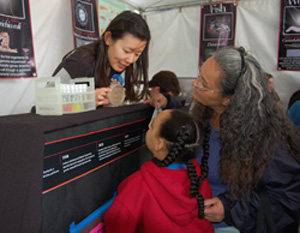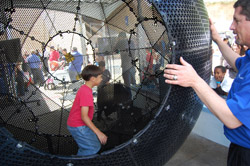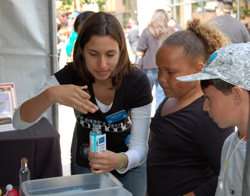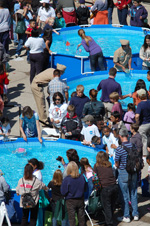Science Festival Launches Home Run at PETCO
From a giant hamster ball to shark jaws, annual science EXPO immerses youth in world of science
Mario C. Aguilera | March 28, 2011

At UCSD's ScienceBridge Program booth, the theme was "San Diego's Next Top Science Model" with a showcase of scientific models used for research and experimentation.
The typical questions bouncing around PETCO Park next week will center on pitcher Heath Bell’s lethal fastball, Chase Headley’s batting average and whether the Padres can make another run for the playoffs. This weekend, however, was a different story. Saturday, science took center stage at PETCO, leading to some decidedly un-baseball-related questions, such as: “Are you ready to extract your own DNA?” “Would you like to see a model of carbon dioxide?” and “Do you want to hold the heart of a cow?” (“Yes!” “Sure!” and “I don’t think so…” were the responses, respectively).
The third annual San Diego Science Festival EXPO Day, organized by UC San Diego and the university’s collaborators, welcomed more than 20,000 people to PETCO Park. Boys and girls and their families from around San Diego County came to the event hungry to learn about the many wonders that science offers.
The EXPO topped off eight days of San Diego Science Festival activities, all focused on inspiring young learners about the promise and power of science, technology, engineering, and mathematics, also known as “STEM.”
“The San Diego Science Festival’s central theme is bringing public education institutions together with the real world of science, engineering and research, so that today’s students will be inspired to become tomorrow’s STEM professionals,” said Loren Thompson, assistant vice chancellor for Student Educational Advancement at UCSD and one of the San Diego Science Festival’s founders. “This year, we really emphasized giving kids the opportunity to meet and talk with hundreds of real-life scientists and engineers. We wanted to show them that scientists are regular, friendly people of all ages and interests, people like who they could grow up to be. The message is that entering a science or engineering career is something you can do, and we want to help you get there.”
Science Festival Managing Director Mary Jo Ball said the 135 organizations presenting hands-on EXPO activities, about 20 percent new this year, pushed the level of interactivity to new levels.

Nine-year-old Jeromey Mascarenhas does his best hamster impression inside Lockheed Martin's VirtuSphere, an immersive virtual training environment.
Nowhere was that more evident than at Lockheed Martin’s exhibit area and its massive “VirtuSphere” attraction, simply described as a “giant hamster ball.” Raymond Bernhagen of Lockheed Martin says the $32,000 VirtuSphere is the only 3-D training simulator of its kind that allows trainees—from soldiers to medical personnel—to walk, jump, roll, crawl and run through virtual environments.
“That was really cool, really fun,” said an exhilarated Jeromey Mascarenhas after testing his agility inside the ominous black orb. The 9-year-old old waited more than an hour to get inside, but his mother said it was well worth it for Jeromey, whose favorite subject is physics.
Beyond giant hamster balls, the festival proved that science can take more subtle forms. Next door in Lockheed Martin’s exhibit was a good old-fashioned, low-tech paper airplane construction booth, complete with distance flying competitions.
Down one level, young guests tried their hand at musical prowess at UCSD Academic Connections’ virtual music station. Intrigued visitors waved their fingers across the air to emit gentle harp notes. The instrument, developed by UCSD Visual Arts graduate student Chris Warren, is a component of “Building Musical Instruments, Real and Imaginary,” one of Academic Connections’ class offerings designed to provide high school students with immersive summer experiences at UCSD.
“Kids love to see how things like this can relate to math and science,” said Ed Abeyta, UCSD director of K-16 Programs. Abeyta notes the importance of extending STEM into “STEAM” by inserting the contributions of “arts” into the mix. “Right brain and left brain become the whole brain,” he said. “Da Vinci was an artist but also one of the best scientists.”

Young guests and their families perused the mix of offerings at the EXPO, including shark jaws and skin offered by Birch Aquarium at Scripps Institution of Oceanography.
Halfway across the stadium, on the deck overlooking home plate, third grader Ruben Barboza was in hog heaven at Birch Aquarium at Scripps Institution of Oceanography’s shark-themed booth, which included jaws, preserved egg casings and shark skin.
“I like sharks because they’ve been on the planet for a long, long time and I like to see them in movies,” said Barboza.
Beyond center field at the Park in the Park, UCSD’s Near Space Balloon Team, part of the California Space Grant Consortium, drew a crowd of excited youngsters. Here was their rare opportunity to control the video feed from a space balloon tethered high over PETCO Park’s festivities.
Kim Wright, a student working for a master’s degree in aerospace engineering, said the ability to control a camera’s panning and tilting from way up above is part of the team’s ongoing community outreach efforts, often in underprivileged areas.
A few booths down, Carolyn Schutt, a graduate student in the Jacobs School of Engineering’s department of bioengineering, eagerly showed off a chronological history of human heart valve replacements. Her infectious enthusiasm pleased the endless crowds that stopped by the booth, but she received dubious stares when she offered guests a chance to hold a jar of pig valves. She happily explained that pig valves can be prepared and used in human heart surgeries.
“Most people know someone who has had heart surgery, so this is an opportunity to show younger people what engineering is and how it relates to biology and medicine,” Schutt said.

UCSD graduate student Carmen Velez explains details of models used in scientific research to eight-year-old Abriana Healy of City Heights.
Across the grass near a giant statue of Padre Hall of Famer Tony Gwynn, another busy UCSD booth seized the title of a popular television modeling reality show and gave it a science twist. UCSD’s ScienceBridge Program, which links university science experts with teachers and students, invited EXPO guests to learn about “San Diego’s Next Top Science Model” by showcasing an array of scientific models used for research and experimentation. Eight-year-old Abriana Healy of City Heights held a model of methane atoms while 10-year-old Anna Mae Lucero of Rancho San Diego learned about carbon dioxide, each explained in detail by local high school students.
Johnnie Lyman, a Scripps Institution of Oceanography graduate student nearing completion of her doctoral degree, impressed upon booth visitors that laboratory experiments can include various organisms, from worms to fish.
“Excite your mind,” was the theme of this year’s Science Festival events, with more than 50,000 participating in activities around the county.

EXPO visitors try their hand at navigating sailboats and robots, above and below the surface, at Saturday's Festival EXPO day.
Organized by UCSD, the 2011 San Diego Science Festival was supported by Life Technologies, the National Science Foundation, Celgene, Gen-Probe, Agilent Foundation, ResMed Inc., Sapphire Energy Inc., Think Blue—City of San Diego, Vertex Pharmaceuticals Inc., Accelrys, Gilead Foundation, Pfizer Inc, SCE-San Onofre Nuclear Generating Station, San Diego Gas & Electric, Science Applications International Corporation, Sequenom Inc., BioAtla, Elsevier, EMD Millipore, Kaiser Permanente, NuVasive, Scripps Health, San Diego Chapter of the National Defense Industrial Association, Novartis Institute for Functional Genomics Inc., and Genoptix.
Community collaborators included Birch Aquarium at Scripps Institution of Oceanography, Collegiate Confidence, CONNECT, Cymer, General Atomics, San Diego State University, Greater San Diego Science and Engineering Fair, Mad Science, Ruben H. Fleet Science Center, RunCoachJason, San Diego Coastkeeper, San Diego River Park Foundation, Senomyx, The Classical Academies, The Maritime Alliance, The Scripps Research Institute, Tijuana Estuary, UC San Diego Extension, and the YMCA.

|